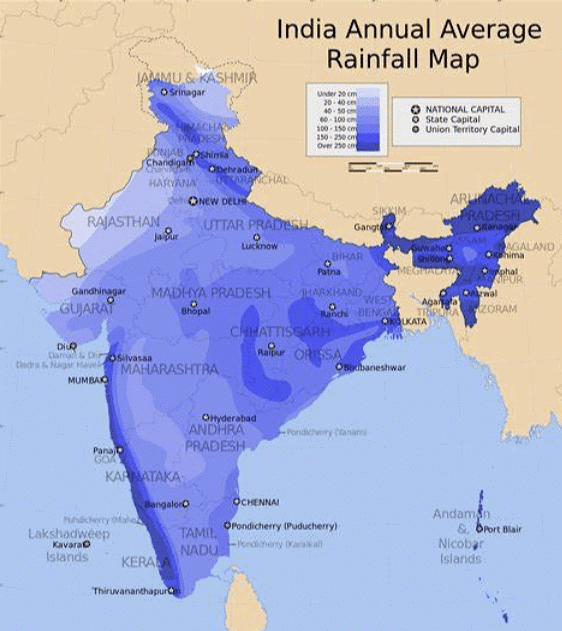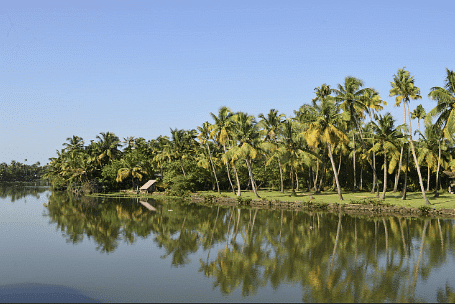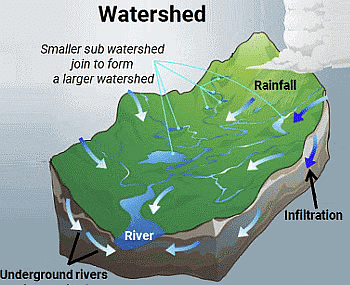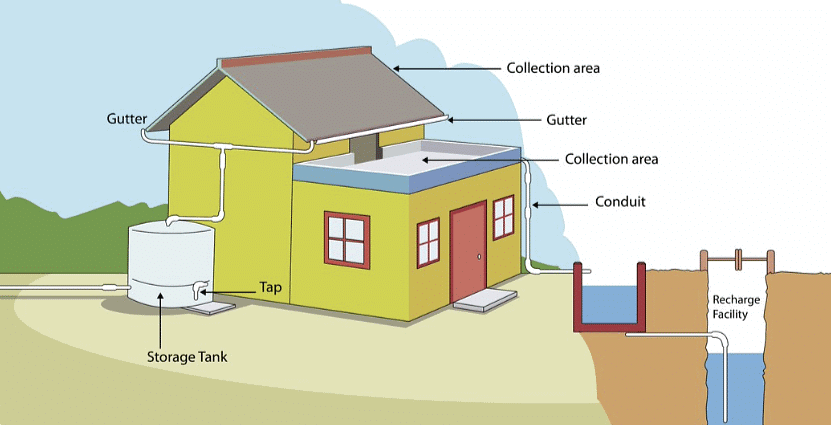Humanities/Arts Exam > Humanities/Arts Notes > Geography Class 12 > Chapter Notes - Water resources
Water resources Class 12 Geography
Water Resources of India
- India's landmass makes up around 2.45% of the world's total area, while its water resources constitute approximately 4% of the global total, and its population represents roughly 16% of the world's population.
- Annual precipitation provides India with 4000 cubic km of water, and an additional 1869 cubic km comes from surface and groundwater sources. However, only 60% (1122 cubic km) of this water is useful and can be utilized.

Surface Water Resources
- India relies on four main sources of surface water resources, including rivers, lakes, ponds, and tanks.
- The country boasts a total of 10,360 rivers and tributaries, each of which is at least 1.6 km long.
- Although the mean annual flow in all of India's river basins is estimated to be 1,869 cubic km, only about 690 cubic km or 32% of this water can be utilized due to topographical, hydrological, and other constraints.
- The flow of water in a river is primarily controlled by the size of its catchment area/river basin and the amount of rainfall in that catchment area.
- In India, rivers have more water during the monsoon season than during other seasons.
- Some of India's most significant catchment areas are found in the Ganga, Brahmaputra, and Indus rivers.
- Despite having only 33% of India's surface area, these rivers, along with the Barak, receive high rainfall and account for 60% of the country's total water resources.
- However, much of this water is not utilized.
- In contrast, the Peninsular rivers, such as the Godavari, Krishna, and Kaveri, have a lower mean annual flow of water.
- Still, most of their water resources have already been utilized.
Question for Chapter Notes - Water resourcesTry yourself:India is the ------largest producer of fruits and vegetables in the world.
View Solution
Groundwater Resources
- India's total replenishable groundwater resources amount to around 432 cubic km. The Ganga and Brahmaputra basins account for approximately 46% of these resources.
- The North-Western and Southern river basins of India have a relatively high level of groundwater utilization. Punjab, Haryana, Rajasthan, and Tamil Nadu are the states with the highest level of groundwater utilization. Gujarat, Uttar Pradesh, Bihar, Tripura, and Maharashtra have a moderate level of utilization, while Chhattisgarh, Odisha, and Kerala have a low level.
- If the current rate of groundwater utilization continues, it could potentially limit development and result in social upheaval and disruptions.
Lagoons and Backwaters
- Several Indian states, including Kerala, Odisha, and West Bengal, have indented coastlines that have given rise to numerous lagoons and lakes.
- These water bodies contain brackish water, making them ideal for fishing and irrigating certain types of crops, such as paddy and coconut.

Water Demand and Utilisation
- Agriculture is a crucial component of India's economy, and it alone consumes around 89% of surface water and 92% of groundwater.
- Many developmental projects and river valley projects, such as the Bhakra-Nangal, Hirakund, Damodar Valley, Nagaijuna Sagar, and Indira Gandhi Canal project, as well as five-year plans, were initiated to provide water for the agricultural sector and increase agricultural production.
- In addition to this, surface water and groundwater are utilized for domestic purposes, accounting for 90% and 3%, respectively, while the industrial sector utilizes 2% of surface water and 5% of groundwater.
Demand of Water for Irrigation
- In India, the need for irrigation is significant due to the irregularity of rainfall in both time and space.
- Since the winter and summer seasons are generally dry in most areas, agriculture cannot be practiced without irrigation.
- Certain crops, such as rice, sugarcane, and jute, are highly dependent on water for their growth.
- Irrigation is critical for growing multiple crops, increasing agricultural productivity, and achieving higher yields in a shorter period of time, especially when combined with high-yielding variety seeds.
- For example, Punjab, Haryana, and Western Uttar Pradesh have over 85% of their net cultivated area under irrigation.
- In Punjab, 76.1% of the net irrigated area is covered by wells and tube wells, while in Haryana, it is 51.3%.
- These states heavily rely on groundwater resources, which has led to their depletion over time.
- Furthermore, in Rajasthan and Bihar, excessive groundwater withdrawal has resulted in an increase in fluoride concentration, while in West Bengal and Bihar, it has led to an increase in arsenic concentration.
- Overall, irrigation is crucial for Indian agriculture, but it also poses several challenges, such as the depletion of groundwater resources and the contamination of water sources due to excessive use.
Question for Chapter Notes - Water resourcesTry yourself:Kalyan, Sona, Sonalika are the hybrid varieties of
View Solution
Emerging water problems
- The diminishing availability of drinkable water in India is attributed to the swift increase in population and contamination from different sources such as domestic waste, agriculture, and industries.
- Furthermore, the per capita water availability in the country is gradually decreasing.
Deterioration of Water Quality
- The term "water quality" denotes water that is devoid of undesirable impurities such as microorganisms, chemicals, and industrial or other wastes, which can contaminate water bodies like lakes, streams, rivers, and oceans.
- These harmful substances are responsible for water pollution, as they dissolve or remain suspended in the water. In some cases, such pollutants infiltrate the ground and pollute the groundwater. The rivers most affected by pollution in India are Ganga and Yamuna.
Water Conservation and Management
- As the availability of fresh water decreases and demand for it increases due to population growth, water conservation and management become essential.
- The government should promote the adoption of practices like watershed development, rainwater harvesting, recycling and reusing water, and the conjunctive use of water to ensure sustainable development and maintain a good quality of life.
- These practices will also ensure the availability of quality water for an extended period.
Prevention of Water Pollution
- Water resources are rapidly decreasing, particularly in densely populated plains, which suffer from low quality water due to widespread usage in irrigation, domestic and industrial activities.
- These areas also contribute heavily to water pollution through agricultural and industrial waste as well as domestic refuse.
- In summer, water levels reduce, and pollutants concentrate in rivers.
- The Central Pollution Control Board, in collaboration with State Pollution Control Boards, monitors water quality at 507 stations.
- The recorded data shows that major rivers in India, including the Yamuna, Sabarmati, Gomti, Kali, Adyar, Cooum, Vaigai, Musi, Ganga at Kanpur and Varanasi are heavily polluted with organic and bacterial contaminants.
- Groundwater in different parts of the country is also polluted with high concentrations of toxic heavy metals, fluoride and nitrates.
- To manage and conserve water resources, it is necessary to adopt measures like watershed development, rainwater harvesting, recycling and reuse of water, and conjunctive use of water for sustainable development and long-term availability of quality water.
Legislative Provisions and Laws to Prevent River Pollution
- Despite the government's efforts to curb river and water pollution through various measures, their effectiveness has been limited due to several obstacles. For instance, Acts like the Water (Prevention and Control of Pollution) Act of 1974 and the Environment Protection Act of 1986 failed to prevent the establishment of 251 polluting factories along rivers and lakes in 1997.
- Similarly, the Water Cess Act of 1977, which aimed to prevent pollution, has also been inadequate. Therefore, there is an urgent need to raise awareness among the public about the importance of water and its conservation. This will help to reduce pollutants from agricultural and industrial activities.
Recycle and reuse of water
- Reusing and recycling water is a cost-effective and practical method to preserve fresh water and ensure its availability for everyone. Industries can utilize low-quality water and even their own wastewater for certain purposes such as cooling and fire-fighting, thereby reducing their water expenses and conserving fresh water for other purposes.
- After using water for activities like bathing, washing utensils, clothes, and cars, it can be effectively used for gardening. Although currently only a few people practice water recycling and reuse, there is immense potential for replenishing water resources through these methods.
Question for Chapter Notes - Water resourcesTry yourself: What is an effective method to conserve water resources and ensure their availability for everyone?View Solution
Watershed Management
- Efficient management and conservation of surface water is the primary goal of watershed management, encompassing a range of activities.
- Groundwater resources are managed, surface runoff is prevented, and ground-water is stored and recharged through methods such as percolation tanks and recharge wells.
- All natural and human resources are conserved and judiciously used to create a balance among natural elements and in society.
- Community participation is crucial for the success of any Watershed Development programme.
- The Indian government has launched several Watershed Development and management programmes at the national and state levels, such as Haryali, Neeru-Meeru, and Arvary Pani Sansad.
- For example, Haryali, sponsored by the central government, is executed by the gram panchayats of different villages with public participation.

- The programme has enabled people to conserve water for various purposes, including drinking, irrigation, fisheries, and afforestation.
- Similarly, the Neeru-Meeru Programme in Andhra Pradesh and Arvary Pani Sansad in Alwar, Rajasthan, are examples of state-initiated watershed development programmes.
- These programmes involve the construction of percolation tanks, dugout ponds (johad), and check dams for water harvesting with the help of public participation.
- Tamil Nadu is the only state that has made the construction of water harvesting structures compulsory in houses.
- Building construction without water harvesting structures is not permitted.
- Despite such programmes, many people in India remain unaware of the benefits of watershed development and water management.
- Therefore, more people need to be encouraged to participate in these programmes.
Rain Water Harvesting
- Rainwater harvesting is an economical and eco-friendly method that involves storing rainwater in bore wells, pits, and recharging groundwater aquifers for various purposes.
- This technique provides several benefits, such as increasing water availability, preventing a decline in groundwater level, enhancing the quality of groundwater by diluting pollutants like fluoride and nitrates, preventing soil erosion and flooding, and even stopping saltwater intrusion in coastal regions by recharging aquifers.

- In India, there are many methods of rainwater harvesting.
- In traditional methods, water is collected in surface water bodies like lakes, ponds, and irrigation tanks in rural areas.
- Another common technique is the kund or tanka, which is a covered underground storage tank widely used in Rajasthan.
- Additionally, rainwater harvesting structures can be built in open spaces or on rooftops of houses, providing a sustainable source of water for a large number of people and reducing dependence on groundwater.
Other Methods
- One potential solution to address water scarcity is to desalinate brackish water found in arid, semi-arid, and coastal regions.
- Additionally, interlinking rivers can be used to transfer water from regions with excess water to those experiencing water shortages.
Highlights of India’s National Water Policy, 2002
- According to the National Water Policy of 2002, the priorities for water allocation are as follows: drinking water, irrigation, hydro-power, navigation, industrial use and other purposes.
- The primary goals of this policy are to ensure that all humans and animals have access to water, regularly monitor the quality of surface and groundwater, promote awareness of water as a limited resource, encourage people to conserve water through education and regulation, and provide incentives and disincentives.
Question for Chapter Notes - Water resourcesTry yourself:The crops sown in November and harvested in April-May are called
View Solution
The document Water resources Class 12 Geography is a part of the Humanities/Arts Course Geography Class 12.
All you need of Humanities/Arts at this link: Humanities/Arts
|
50 videos|273 docs|37 tests
|
FAQs on Water resources Class 12 Geography
| 1. What are the main factors contributing to the deterioration of water quality in India? |  |
Ans. The main factors contributing to the deterioration of water quality in India include industrial pollution, agricultural runoff, untreated sewage discharge, and improper waste management practices.
| 2. How does watershed management help in maintaining water quality in India? |  |
Ans. Watershed management helps in maintaining water quality in India by promoting sustainable land use practices, preventing soil erosion, controlling runoff, and reducing pollution inputs into water bodies within a specific watershed area.
| 3. What are some of the key challenges faced in managing water resources in India? |  |
Ans. Some of the key challenges faced in managing water resources in India include water scarcity, over-extraction of groundwater, pollution of water bodies, inefficient irrigation practices, and lack of proper wastewater treatment facilities.
| 4. How does the government of India address the issue of deteriorating water quality in the country? |  |
Ans. The government of India addresses the issue of deteriorating water quality through various initiatives such as the National Water Quality Monitoring Programme, setting up pollution control boards, implementing water conservation policies, and promoting sustainable water management practices.
| 5. What are some effective measures that can be taken at the individual level to help improve water quality in India? |  |
Ans. Some effective measures that individuals can take to help improve water quality in India include reducing water wastage, properly disposing of waste, using eco-friendly products, adopting water harvesting techniques, and supporting conservation efforts.
Related Searches






















